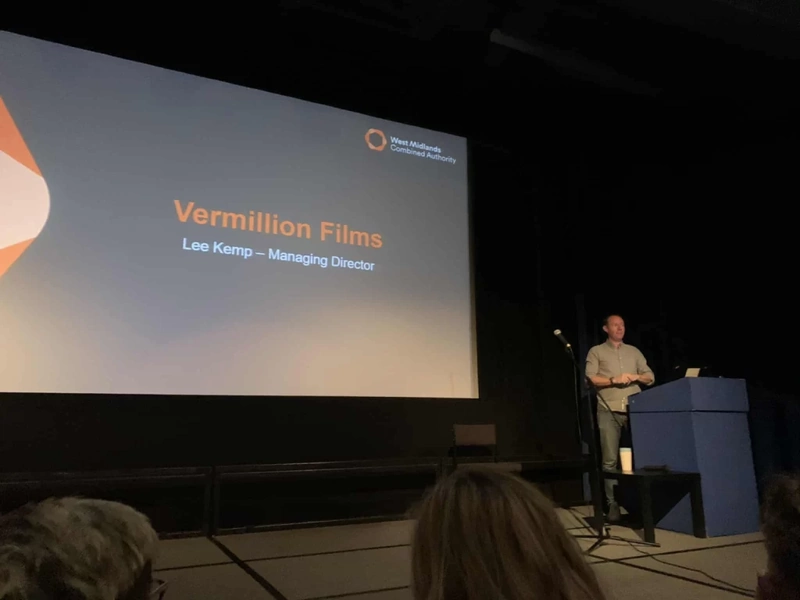our thoughts
BLOG
TOP TIP: SEND THANK YOU CARDS

Last week I spoke at the launch of the DCMS Creative Enterprise Scaleup Programme. Vermillion was one of three companies speaking on the day, talking about our experiences of running creative video production company in the West Midlands. We were asked to speak about both the challenges and the opportunities presented by working in the West Midlands region of the UK and it was a refreshing opportunity to go through some of our own thinking that lay behind our strategic decision-making of the past couple of years. I’ve laid out some of our challenges here because we got really great feedback from the room and over the years we’ve sat down with some baby video production companies that have reached out for advice. Yeah they’re competition but also we’re confident enough to stand on our own two feet. Hopefully sharing it here will help some others get over the brick walls we’ve foolishly run head first into.
It’s worth bearing in mind that 94.8% of creative businesses employ fewer than 10 people. This is particularly staggering given that the creative industries are worth £101.5 Bn to the national economy. This means a very significant proportion of people in the creative industries are dealing with challenges that would generally be under the purview of ‘management’. If stats are your thing check out the links at the end too.
Traditional Industry
Filmmaking is a relatively old and traditional industry. The sort of huge revenue-generating, financially exploitable macro innovation doesn’t tend to happen in our bit of the industry, it’s in the physical tactile part of the industry (cameras, LED lights etc) or the bit where our creativity is injected directly into your eyeballs (distribution, metrics etc). We tend to be more micro-innovation; three good ideas in response to a brief or a client problem. One might argue that we could be developing our own IP, and we are, but it takes time and so is everyone else. Once you get past the point of shooting everything yourself then you need crew and crew are generally a fixed cost (see below). The key part of where we (and other production companies) differentiate is sector expertise, it is not pretty pictures.
Top tip – differentiate. Find your niche. Ours has traditionally been agriculture video production and rail but is increasingly moving towards fast growth businesses and startup video production (more on that later).
Barriers to Entry
I think there are three key factors dramatically lowering the barriers to entry into the filmmaking industry; technology, education and mindset. The consequence of lower barriers to entry leads to a crowded market place and increased competition applies downward pressure on pricing.
Prior to the launch of the Red One a digital cinema camera would cost over $200,000. Today a Sony FS-7, the camera we shoot much of our corporate work on, is about £7k. With a metabones lens adaptor and Canon lenses you can be shooting fantastic 4k imagery in no time. Furthermore lighting has moved from being heavy, expensive equipment to relatively cheap, lightweight and low-powered LED technology.
In conjunction with this the education establishment has recognised the industry as a fertile opportunity for vocational degrees. Many graduates go into other industries or crafts within this industry, but a good number set up on their own with a lower price model that works in exchange for experience. While most learn the value of a sustainable revenue model fairly quickly they’re replaced by a new cohort each year.
The final, and most important, point is about mindset. The smartphone means there’s a cinema quality camera in every pocket. You can argue the distinction about cinema quality all you want but it’s unimportant, almost nothing we make is seen in the cinema. The ubiquity of the technology means there has been a huge change in mindset over the past decade about our ability to create our own content and some people have organically that they love it (hello TikTok).
The barriers to entry are now barely speed bumps which means the field is crowded.
Top tip: Hire them. You should be growing out of doing it all yourself as soon as you can anyway. Out of nowhere we found two young production companies were eating our lunch. Thankfully one of them has made themselves effectively unhireable because of their atrocious service but the other one, who were the triple threat (good, fast and cheap) now work for us. In other cases we’ve hired people as directors or crew.
Big Brands
Over time the pack falls away and only the viable companies are left standing. In a crowded market companies seek to differentiate and move up the value chain. We’ve certainly done so but this comes with its own interesting challenges because inevitably bigger brands tend to have less flexibility around the payment terms. Even if you’ve delivered the best, most viral piece of work on the planet, you haven’t delivered it to the finance team and they’re operating under an entirely different set of rules and pressures. Try and remember that these 60-90 day terms aren’t the fault of the person you’re on the phone to on a Friday afternoon. From a business perspective this means that cash is just more expensive for small businesses. We often get freelancers just telling us to not take this work; we’re an established production company on a growth curve and even we don’t feel like we can turn down paying big brand work. All we can do is plan, communicate well and try and win enough work to offset it.
Top tip: send thank you cards to finance people.
No Retained Work
I spoke to a production company last week that had signed a contract for video content retained work. It’s only the second time I’ve come across this since I started making films in 2004. Until you start building up any kind of reserve you’ll have to kill to eat every single month. Surviving in this kind of marketplace takes time, patience and nerves of steel.
Top tip: Communicate well with your suppliers; most will appreciate your honesty and most will tell you if they’re desperate for cash.
Highly Unionised Labour Force
Once you start working above a certain scale you will require crew, who are highly unionised. A lot of what I’ve discussed above results in downward pressure on prices but the cost of production doesn’t actually change that much. Most production companies exist between the hard place of clients with limited budgets in a crowded market place and the rock of fixed (unionised) production costs so the decision ultimately comes down to how much margin are you willing to make on any given job?
Top Tip: Know your own value. Be willing to fight for it. Be willing to lose work over it.
This was only the first half of my talk last week. The second half was about how we as a company have overcome these issues and the opportunities we’ve gained as a consequence. These are largely around positioning and structure and I’ll blog about these in the next couple of weeks.
FYI the other speakers were Coventry based Imagineer and Simworx in Kingswinford. Both were great. Imagineer is an arts organisation which comes with its own challenges but they have a very clear mission. Simworx are a particularly fascinating company building immersive reality roller coaster rides and have successfully scaled up by several orders of magnitude in the past few years. Check ’em out, they’re both awesome.
Some creative industry stats, as promised:
Economic Impact – https://www.creativeindustriesfederation.com/statistics
A Regional Slant – https://gbslep.co.uk/wp-content/uploads/2019/03/West-Midlands-Creative-Industries-STATS-2019.pdf
Launch of the DCMS Programme – https://gbslep.co.uk/wp-content/uploads/2019/03/West-Midlands-Creative-Industries-STATS-2019.pdf


